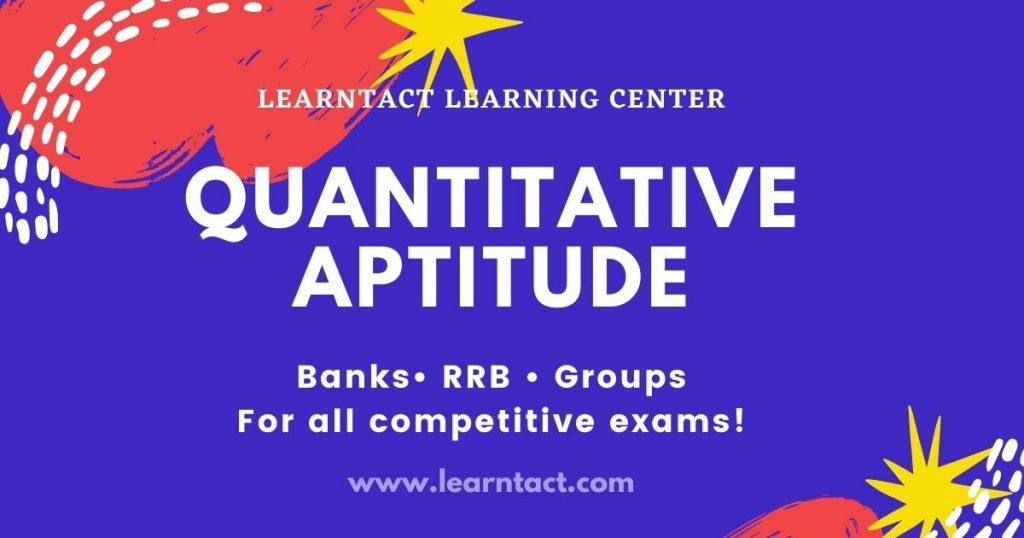- Description
- Course Content
- What you'll learn?
Quantitative Aptitude is the most important syllabus for clearing any competitive exam. It simply means the ability of an individual to solve numerical and mathematical calculations. This is very important because a person with quantitative aptitude will be in a better position to analyze and make sense of the data given. This is why all the competitive exams like Bank Clerk, PO's, SSC, CHSL, Groups, SI, Constable etc will test you regarding this ability. Some tests even consider this as preliminary i.e., you'll be proceeded to next stage only if you score good enough marks in Quantitative Aptitude. This is the same reason why, every college student participate in Campus Recruitment Training (CRT).
Our course consists of all the concepts required to give you a sound understanding of Quantitative Aptitude. You don't even necessarily apply for a job to learn Quantitative Aptitude, these skills you learn are helpful throughout your life whether it is in business, investing, checking balance sheets, calculating profits quickly, percentages, analysis by some quick formulas which don't actually take much of your time. In exams, you'll be presented with around 1 minute or less to solve these type of questions, which you can do only with some practice. Whether it is in exam or life, you shouldn't take much time for making calculations.
By learning this course it improves your:
- Calculation Skills: The ability to quickly calculate percentages, gain, loss in any transaction with lightning speed requires some practice and techniques. For example, you don't always need calculator to do a calculation or calendar to find the day of any date
- Problem Solving: By solving numerous problems here, you'll develop a knack for easily looking solutions to problems. This problem solving skills can easily be transferred to other domains. For example, if you are a programmer you need problem solving skills to break down the question and then create the actual code for it.
- Mental Alertness: Some tricky questions, check your mental alertness by puzzling your brain. You don't need to actually solve the problem to get the solution fast, there is always an alternative approach.
- Accuracy: It doesn't matter if you are fast enough, but not accurate. Speed and accuracy are both needed. With enormous data at your disposal, you need to be wary to not committing any errors.
QUANTITATIVE APTITUDE
- Number System
- L.C.M and H.C.F
- Decimal Fractions
- Simplification/Approximation
- Surds and indices
- Sequence & Series
- Quadratic Equations
- Time & distance
- Problems on Ages
- Algebra (Square roots, Cube roots)
- Ratio and Proportions
- Averages
- Profit and Loss
- Probability
- Permutations & Combinations
- Alligation & Mixtures
- Time and Work
- Percentage
- Simple Interest
- Compound Interest
- Mensuration (2d and 3d), Area
- Geometry
- Unitary Method / Chain Rule
- Calendar
- Problem on trains
- Races
- Banker’s Discount
- Pipe & Cisterns
- Boat and Stream
- Clocks
- Calculating sum of n natural numbers
- Calculating sum of squares/cubes of n natural numbers
- Divisibility Rules of each number
- Shortcut to find number of factors of a number
- Finding remainder of divisions of big numbers
- Calculating LCM and HCF of numbers and fractions
- Solving remainder problems in LCM and HCF
- Prime Factorization Method
- Long Division Method
- Solving ratio based problems
- What are different types of decimal fractions
- Basic Algebrae formulas
- Solving Decimal equations quickly
- Simplification of expressions using 'VBODMAS' Rule
- Shortcuts to calculate percentages of a number
- Finding square roots of any number
- Solving infinite square root problems
- Laws of Indices
- Laws of Radicals/Surds
- Solving problems involving Surds and Indices
- Different types of sequences and series
- Different types of Progressions and calculating their sum, nth term and last term
- Calculate different types of Means (Arithmetic, Geometric, Harmonic)
- Solving quadratic equations finding their discriminant, roots, sum and product of roots
- Solving time-speed-distance problems
- Finding average and relative speed
- Solving train problems
- Finding speed and time taken by train to cross objects of different lengths or another train
- Solving age based problems
- Solving algebraic expressions
- Calculating ratio and proportions
- Finding averages of observations with mistaken entry when corrected
- Calculating Profict and Loss and their percentages
- Finding probability of random events
- Finding permutations and combinations of numbers
- Finding all arrangements of words with/without repeated letters
- Solving Alligation/Mixture problems
- Rule of Alligation
- Finding time and work done by n number of people in certain days
- Calculating Simple Interest and Compound Interest with different interest rates for different years
- Finding areas and volumes of different 2D & 3D objects
- Solving geometry based problems
- Calculating direct and indirect proportions
- Chain Rule
- Finding day if date is given (Calendar based problems)
- Finding time lead/lag in a race (Races and Games)
- Calculating Banker's Discount and True Discount
- Finding present value and face value of loan
- Finding time taken by a pipe to fill a tank (Pipes and Cisterns)
- Finding speed of boat in still water or a streams (Boats and Streams)
- Finding angle between hands of clock or time gained by one hand over another (Clocks)
